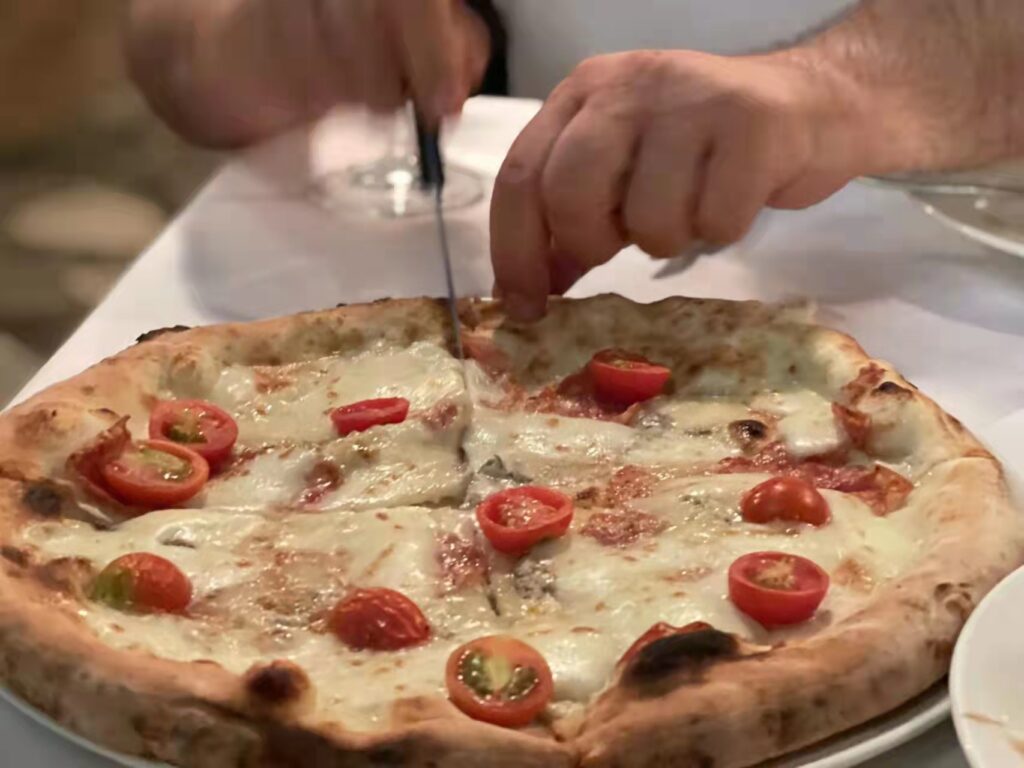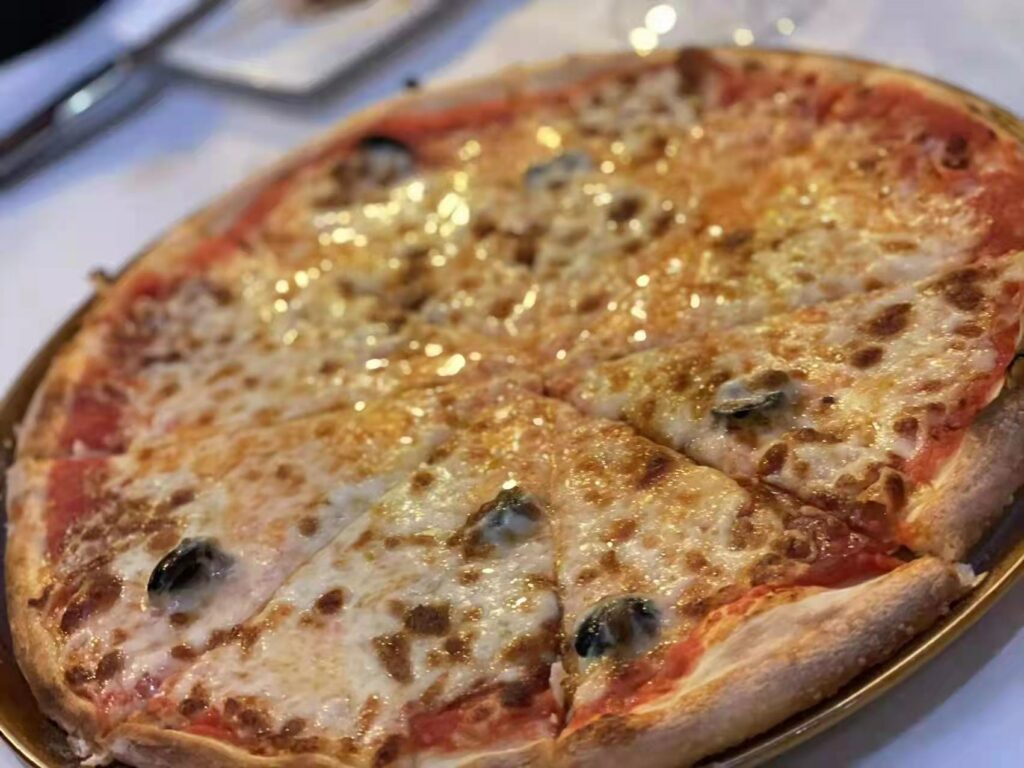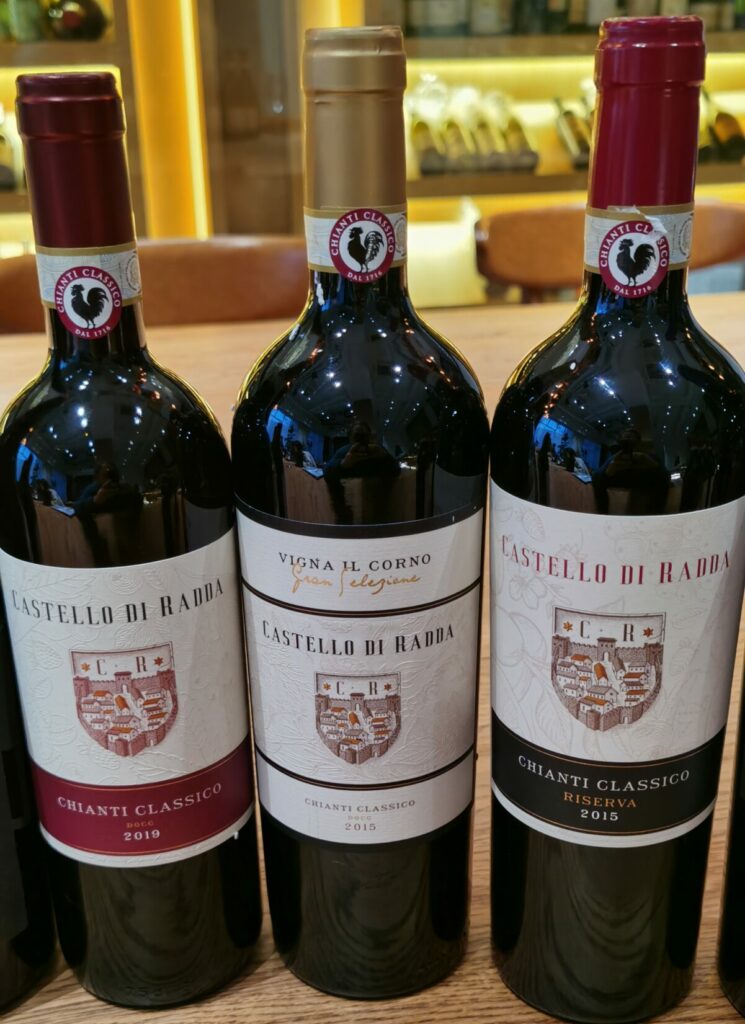In this three-part series devoted to one of the world’s favourite foods, pizza, a group of wine and food experts (somms, educators, importers, writers) will analyze and discuss which wines match best with pizza. Given how popular and ubiquitous this food is, helping everyone to know and understand it better, not to mention presenting a discussion on the wines to drink alongside with it, seems like it might be both helpful and very enjoyable, even interesting, reading. Let us know what you think, we’d like to know what your thoughts are on the subject. So, what are your favourite wines to have with pizza?

Pizza, popularity personified
Let’s keep this simple: pizza is not “just” wildly popular. That’s because the world “wildly” doesn’t even begin to communicate just how popular that disc of dough with toppings really is. How popular, you ask? Well, where does one begin?
According to a 2019 review by Zach Links (How Much Pizza Does the Average American Eat in a Year? – Slice Pizza Blog (slicelife.com)), in the United States of America alone, there are an amazing 3 Billion pizzas consumed per year, with the average American eating around 40 pizzas a year. Or putting it another way, Pizza Statistics 2022: Consumption Trends & Industry Data (muchneeded.com) estimates that Americans eat 350 slices of pizza each second. Every day, 13% of the American population eats some type of pizza and 17% of the country’s restaurants are pizzerias: in New York City alone, there are 9,000 pizzerias (pre-Covid times data). It’s more or less the same in Canada: according to the Food by Numbers-Food consumption in Canada report (By the Numbers – Food consumption in Canada – UFCW Canada – Canada’s Private Sector Union) about 14% of Canadian dinner-time meals are of pizza. Furthermore, as a sign of the huge interest there is amongst Canadians for pizza, the 2018 Canadian Pizza Consumer Trend Report suggests 45 per cent of Canadians would like more authentic pizza, that 22% then wished for unique toppings or ingredients compared to two years prior, and that a quarter of Canadians consider pineapple on pizza to be “blasphemy.” Italy’s numbers are just as staggering: One and a half billion pizzas per year, which is less than the numbers boasted by the USA, but spread over a population of about 60 million inhabitants (granted, there are also about 60 Million tourists a year, all of whom seem to have an insatiable hunger for pizza), meaning that in Italy about 5 million pizzas are baked every day (Tirreno Ct, the catering fair staged in Carrara). In fact, you’ll be surprised to know that neither the USA nor Italy rank first in pizza consumption per inhabitant: that honour belongs to Norway (Who Eats the Most Pizza in the World? The Answer May Surprise You – Pure Travel). In fact, Norwegians are the world’s biggest consumers on a per-person ratio (with a population of about 5.5 million, Norwegians each eat about 5 kilograms of pizza annually). According to the same data, in this particular classification, the USA ranks second, the United Kingdom third, Germany fourth, and Italy fifth.
Still, those are all rather amazing numbers no matter how you want to slice them (a very appropriate term, given it is pizza we are talking, er writing, about). But the signs of pizza love don’t just start and stop with those statistics, because there are all sorts of other indicators attesting to pizza’s amazing, earth-shattering, headshaking, wondrous, incredible popularity (there, I think I came up with some better options than “wildly”). You like lists? Well, pizza has got those covered too, for it makes it into just about any “Top 5 or 10 world favourite foods” list you can think of, and most often shows up at number one: go ahead, peruse to your heart’s content. The Top 10 Lists has pizza at number one in its Top 10 (Top 10 Favorite Foods | Best Tasting | Top Dishes – TheTopTens), just ahead of ice cream at number 2, fried chicken at n.3, chocolate at n.4 and French fries at n.5. A very similar list, though the standings are slightly different, is Matt Taylor’s list of the ten most popular foods in the United States (Most Popular Foods in America | In The Kitchen With Matt), in which pizza sits in fifth place, just behind Oreo cookies (n.4), French fries (n.3), hot dogs (n.2) and of course, hamburgers (n.1), conspicuously and perhaps surprisingly absent from the top 5 in the preceding Top Ten list I mentioned (there they clock in at n.6). At CNN Travel (World food: 50 best dishes | CNN Travel) their “The World’s 50 best Foods”, pizza napoletana (or Neapolitan pizza, as they write it) slots in at number 2, right after Thailand’s Massaman curry (really?) and chocolate at number three. The World Travel Connector (58 Most Famous Foods Around the World: Best National Dishes (worldtravelconnector.com)) has pizza (with welcome and I dare say much-needed precision, they write “Italian pizza”) in its almost usual (rightful?) number 1 spot, with Turkish Doner kebab at n.2 and American hamburger at n.3. Given that we live in a world where image is often more important than substance, any mention of lists would not be complete without consulting YouTube; and so, the YouTube list of the 10 Most Popular Foods in the World (Top 10 Most Popular Foods In The World – YouTube) has pizza as the top dog, qualifying it as “…the most famous and popular food in the world”. At first quick shocking glance, much less into pizza appear to be the folks at tasteatlas, who have pizza Margherita listed only at n.99 of the their “The 100 most popular foods in the world” (100 Most Popular Foods in the World – TasteAtlas) and pizza napoletana at n.87 (now really: There are more people out there who prefer eating pizzas with anchovies rather than without? Uhm…) but before you start thinking that these folks obviously need to get out more or check into marital counselling to get help so they can cheer up a little (I mean, what else can you really think of people who place satay only at n.98, have eclairs languishing at n.95, apple pie at n.90 and chocolate mousse at n.89? I mean, apple pie and chocolate mousse, for Pete’s sake!)… But all kidding aside, they do recoup their credibility losses by placing pizza outright at NUMERO 1, beating out sushi at n.2 and the all-mighty hamburger at n.3!!!! So congratulations are in order (I was really worried there for a while and almost choked on the slice of pizza I was scarfing down while reading the article)!!! After all that, and seeing just how popular this foood is, knowing a little about how pizza came to be ought to prove interesting to most everyone.
The history of pizza
Pizza’s history is an antique one, as flatbreads with some form of topping have been cooked and prepared for millennia. It appears that already back in 3.000 B.C., the use of yeast to raise wheat products was known in Sardinia; the ancient Egyptians also certainly knew of yeast too. Discs of bread called plakous were consumed by the ancient Greeks, and the ancient Persians also ate a flattened bread with different toppings. In ancient Rome, edible discs were routinely made with many different flours, so as to be able to enjoy foods with different textures and flavours.
That much admitted, pizza as we know it today is a later creation, and indelibly associated with Italy (or more precisely, the collection of city-states and regions that later became Italy). And in fact, the word “pizza” first appears as such within the future country’s borders: documents show that the term pizza derived from a colloquial Latin term, and was in use already in AD 997 in the city of Gaeta (the word appears in a contract detailing the rental of a flour mill located in the territory of the modern-day commune of Castelforte). Later, the word appears again in a rental agreement (dated January 31, 1201) in Sulmona. Like everyone else, pizza has its ancestors, morphing slowly in time to the food we all know today. Everyone more or less agrees that modern-day pizza was born in Naples, most likely sometime between 1500 and 1600. At that time, there was a pizza called “Mastunicola”, basically a disc of cooked flour topped with a variable mix of lard, sheep cheese, black pepper, crispy fried fat, and basil, the ultimate street food. Another ancestor was the “pizza cecinelli” (or “pizza alla cecinelli”), where the pizza was topped with the cecinelli (or bianchetti, aka. fish fry). Tomato-based pizzas were born only in the mid-1700s, when the tomato was brought to Europe for the first time, most likely subsequent to the discovery of the American continent by Christopher Columbus (yes, Columbus discovered Central America in 1492; the time lag in using tomatoes in the kitchen is due to the fact that the plant was initially thought to be poisonous and used mostly for ornamental purposes, but that’s a story for another time, ie. another upcoming article). Many famous men of letters wrote about pizza: in 1843, Alexandre Dumas Père of The Three Musketeers and The Count of Montecristo fame) described the many pizza toppings in use at the time, as did the Swiss publisher Francesco de Bourcard who documented in 1866 that the most typical pizzas of Naples (pizza only became a national phenom only in the early- to mid-1900s, with the establishment of pizzerie all over the country) in those times featured toppings including olive oil and garlic, perhaps with a little basil, cheese, tomato, and/or oregano added for good measure. The most classic of all Neapolitan pizzas, pizza marinara (tomato, olive oil, garlic) dates back to 1734, while the pizza Margherita (created by chef Raffaele Esposito of the historic tavern in Naples “Pizzeria di Pietro e basta così” in honour of Italy’s Queen Margherita of Savoy with tomato, mozzarella and basil to replicate the colours of the Italian flag) was born in 1899.
Pizza and wine
Given that pizza was born in Italy, a country where wine is similarly popular, it follows that pizza and wine have always gone hand in hand (actually, in Italy, a lot of people like to have beer with pizza too). No doubt, there are many wines that can enhance the pizza-lovers experience: so how to best match pizza and wine to get the most enjoyment out of our dining moments?

As general rules go, keep in mind the following. The flour-based disc that is pizza’s base can be viewed as a more or less neutral support to the toppings: In other words, the flavours of a pizza’s toppings will be less pronounced than they would be on their own (much as it is with pasta dishes) and so one should choose a wine accordingly. For example, a wine that is less intense and pungent than the wine we might choose if we were having the same ingredients as a food all on their own (in other words chorizo on its own might want a spicy, full-bodied, strapping red; pizza with chorizo might benefit from a gentler red, say medium-bodied, fruitier, and less spicy). Clearly, the toppings you choose make a world of difference to the final wine choice. Some basic, even classic, guidelines for pizza and wine pairings you might want to follow could be: 1. Choose a red wine with meat toppings 2. Choose a white wine with fish toppings 3. Choose a wine the density/texture of which is comparable to the toppings (in other words, no oaky/buttery Chardonnays if you are having pizza with anchovies, and no oaky Cabernets if you are having a simple pizza with tomato sauce) 4. Choose a wine that has lower acidity than the toppings 4. Choose a wine that has a little more sweetness than the toppings.
But like all food and wine pairings, individual preferences, likes and dislikes, play a huge role, and hey, if you want to have a shot of malt whisky or an ice-cold soft drink with your pizza, go ahead, why not? But to help you try some pizza and wine matches that have some form of thought process behind them, hopefully geared towards helping you enjoy your meal more, read on!
This is part 1 in a three-part series devoted to pizza and wine, for which we have consulted a number of very well-respected, even famous, wine and food experts from all over the world on this very subject. Today, we have opinions from wine writers Michale Apstein (also a medical doctor) and Robert Millman. In parts 2 and 3, to be published weekly in the following two weeks, we report the opinions of famous sommeliers, importers, writers, chefs and restauranteurs from all over the world.
Michael Apstein (wine writer and medical doctor; USA)
Generally, I believe that wines and food “grew up” together. By that I mean that the cuisine of the country helps determine the overall style of the wines. The olive oil or butter-based cuisine of Italy, perhaps explains the wonderful enlivening acidity of Italian wines. You need the acidity to cut through the oil. So one of my “rules” of food and wine pairing is to choose the wine from the country from which the food comes. Simply put, when eating Italian food, drink Italian wine. Pizza is an exception. Though associated heavily with Italy, pizza has become world-wide. Indeed, when we vacationed regularly in the south of France, pizza was on lots of menus and with lots of kinds in restaurants, it was often on the table. Plus, pizza has gone upscale. Lydia Shire, whose decadent lobster pizza caused a buzz at the now closed Biba in the 1980s, still serves it at Scampo, her super Italian-focused Boston restaurant. Marta, one of the restaurants in Danny Meyer’s Union Square Hospitality Group in New York that is especially well-known for its pizza, clearly thinks Champagne is the perfect accompaniment with no fewer than 160 Champagnes on their list. Hence, my recommendations for wine with pizza start with Italy, but extend beyond her boundaries.
For a traditional pairing, I’d choose virtually any Chianti Classico from the spectacular 2016 vintage. You could almost select one with your eyes closed. If I had a choice, I’d reach for the racy and ripe 2016 Isola e Olena Chianti Classico or the dark and juicy one from Castello du Radda. Having truffles on that pizza? Grab a bottle of the herbal Castellare di Castellina 2016 Riserva. All have the energetic Tuscan acidity that will cut through whatever topping is on the pie.

With its acidity and tannic backbone, the structure of Nebbiolo is ideally suited to pizza. The subtleties and complexities of mature Barolo or Barbaresco would be lost with pizza. So, I’d reach for Langhe Nebbiolo, which is far friendlier at a younger age. Specifically, Vietti’s 2017 Nebbiolo Langhe Perbacco. Vietti is one of a handful of producers whose wines never fail to impress. You can safely buy anything Vietti makes. Their 2017 Langhe Nebbiolo displays understated elegance and wonderful austerity. The tannins are apparent, but finely polished. They are not intrusive, but rather add an appealing firmness to the wine, which balances and offsets the tomato and cheese and anything else, for that matter, on the pizza.
I’m firmly in the Marta camp when it comes to pizza. Champagne’s acidity cuts easily through a base of tomato sauce. My go-to non-vintage Champagne is Charles Heidsieck, one that combines power, creamy elegance and a straight spine of acidity. Its richness makes it an ideal choice for a clam pizza, a four cheese one, or the aforementioned one with lobster, while its acidity cleanses the palate in between bites. It’s also just right with a tomato-based pie.
The acidity inherent in the Gamay grape makes Beaujolais, in general, a good choice for pizza. In specific, I’m partial to the Côte de Brouilly. Like Langhe Nebbiolo, but in an entirely different way, the combination of acidity from the grapes and the firmness imparted by the blue stone soil of Côte de Brouilly combines to be a marvelous foil for pizza. And there’s no better producer of Côte de Brouilly than Château Thivin. The 2019 or 2020 Château Thivin Côte de Brouilly both have the requisite power and verve to compete with and offset the flavors of pizza.
Robert Millman’s view (wine writer and retail; USA)

With pizzas that do not feature an exaggeration of toppings, I will likely choose a good Gamay wine (preferably a Fleurie over a Morgon), a Crianza Rioja over an aged one, a Côtes du Rhône, possibly a Vacqueyras (not a tannic northern Rhone), and a New World Pinot Noir wine over Burgundy. In other words, I believe the wine must have expressive fruit and soft tannins. But hey, there is no accounting for tastes and we can all dream: so if you can afford it, perhaps a 1989 Petrus with a white pizza blanketed in thin slices of black truffle? Why not?

(Next week, we will publish part 2 in this “Pizza and Wine” series, featuring the opinions of experts from Italy; the last part, part 3 of this three-part series, published the week following part 2, we will have the opinions and comments of wine and food experts from Canada, South America, Europe, China and the rest of Asia.)

 中文
中文




What a great start to this series, well done. Lots of interesting stats, and a more detailed history of pizza than I have seen before. I suspect that in the USA this weekend (with the Super Bowl on Sunday) pizza will be battling with chicken wings for the most consumed food. Looking forward to the rest of the series. I’m a bit old school, so in my view, I would always choose an Italian wine (or a good beer, that’s always a consideration) to go with pizza. Agree that the toppings should guide the decision on what to pair with it.
I’m with you and it looks like most people are on the same thinking track. As for Italian wines or from other countries, well, that’s more open to debate, and matching local foods with local wines is always a good idea, but we can be open-minded about it and tr something novel too from time to time! In any case, it’s uts fn to mix and match, though again, my tastes veer in your direction!
The combination of a good quality Frappato or lightly chilled fruity red Bardolino always does the trick. They both have that acidity and vivacity to cut through the fat of the cheese and never clash with tomato or umami like toppings. For me pizza is – or should be- happy easy and fast food (of quality). So you need happy easy drinking wines (of quality). Of course that Charles Heidsieck will work out fine but it might suit better in a Ferrari than a Fiat 500 😉
Sounds about right to me! Light-bodied juicy red wines ought to work well with any pizza havng a little tomato on them, and it really does make for a nice match….I’m with you! Ian